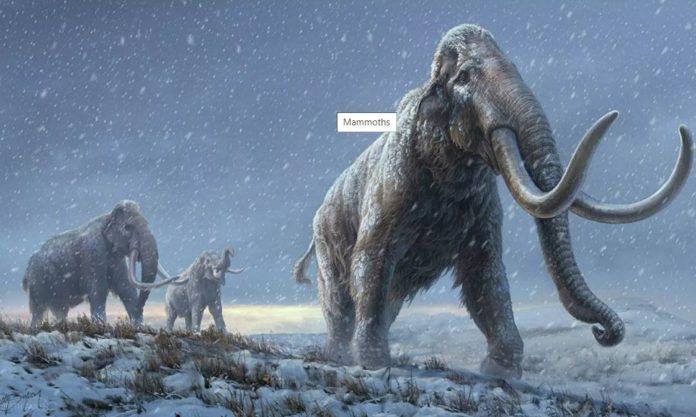A team of scientists discovered that mammoth teeth preserved in the permafrost of Siberia, up to 1.6 million years old, retain the oldest DNA found. By crossing the million-year threshold, researchers may be able to access the earliest histories of other mammals and approximate extinct species.
The scientists reported that they have recovered and sequenced DNA from the remains of three mammoths buried in the permafrost layer suitable for the conservation of genetic material. Although the scientific community discovered the remains in the 1970s, at that time they did not have scientific methods to extract the DNA.
- Does This Mean We Stopped Being Animal and Started Being Human Due to ‘Copy Paste’ Errors?
- The One Lifestyle Choice That Could Reduce Your Heart Disease Risk By More Than 22%
- Aging: This Is What Happens Inside Your Body Right After Exercise
- Immune-Boosting Drink that Mimics Fasting to Reduce Fat – Scientists ‘Were Surprised’ By New Findings
- Gun Violence in America: What They Don’t Talk About at the Debate
“I’ve been waiting for this study for eight years,” confesses Ludovic Orlando, an ancient DNA specialist at the Toulouse Center for Anthropobiology and Genomics in France, who co-directed in 2013 the study that sequenced the oldest DNA at that time: a genome from a bone from horse leg from 560,000 to 780,000 years.
Researchers had always suspected that DNA could survive beyond a million years. Once an organism dies, its chromosomes break into pieces that get shorter over time. In this way, the DNA strands become so small that they even lose their informational content.
Love Dalen, an evolutionary geneticist at the Swedish Museum of Natural History (SMNH) in Stockholm, has sequenced very ancient mammoth remains since he found some in 2007. The samples sequenced by his team include an early woolly mammoth ( Mammuthus primigenius ) and two belonging to a precursor known as the steppe mammoth ( Mammuthus trogontherii), which had been excavated by the Russian paleontologist Andrei Sher.
Dalen hoped that the DNA in the samples could capture the evolution of woolly mammoths and other species in action, but was skeptical about having bad previous experiences with much younger remains found in permafrost.
“It’s not that everything in permafrost always works. The vast majority of samples have DNA that is useless,” he said.
But thanks to advances in sequencing and bioinformatics technology, his team managed to obtain 49 million base pairs of nuclear DNA from the oldest sample, found near the town of Krestovka, and 884 million base pairs from another tooth, named Adycha.
According to DNA analysis, the Krestovka sample was 1.65 million years old, and the Adycha sample about 1.3 million. The third sample, a 600,000-year-old woolly mammoth tooth, named Chukochya, produced almost 3.7 billion base pairs of DNA.
- Does This Mean We Stopped Being Animal and Started Being Human Due to ‘Copy Paste’ Errors?
- The One Lifestyle Choice That Could Reduce Your Heart Disease Risk By More Than 22%
- Aging: This Is What Happens Inside Your Body Right After Exercise
- Immune-Boosting Drink that Mimics Fasting to Reduce Fat – Scientists ‘Were Surprised’ By New Findings
- Gun Violence in America: What They Don’t Talk About at the Debate
The two oldest teeth appeared to belong to steppe mammoths, a European species that is an ancestor of woolly mammoths and Columbian mammoths (Mammuthus columbi), a North American species. The Adycha specimen was part of the lineage that gave rise to woolly mammoths.
Dalen’s team discovered that Krestovka’s specimen belonged to an entirely new lineage. “We cannot say that it is a different species, but it sure looks similar,” explained the scientist. Although the Krestovka sample comes from Russia, Dalen suspects that this lineage was isolated from other steppe mammoths that inhabit North America.
The team found that Columbian mammoths trace half of their ancestry back to the Krestovka mammoth lineage, and the other half to woolly mammoths. The two lineages mixed more than 420,000 years ago, Dalen believes. The idea that new species can be formed through mixing is gaining popularity among evolutionary biologists. But this is the first hybrid speciation test from ancient DNA, says Ludovic Orlando.
Different species of mammoths probably mixed routinely at the time of glacial expansion, says Hendrik Poinar, an ancient DNA specialist at McMaster University in Hamilton, Canada. His team revealed evidence that woolly and Columbian mammoths later interbred.
Tom van der Valk, a bioinformatician at the University of Uppsala in Sweden who spearheaded work on mammoth teeth with evolutionary biologists Patricia Pecnerova and David Díez del Molino at SMNH, hopes this study will encourage other scientists to pursue this line of research. research.
The results of the study were published in the journal Nature.
By crossing the million-year threshold, ancient DNA researchers might be able to access the first stories of other mammals large and small, Dalen concludes.
